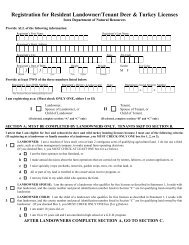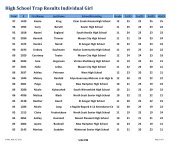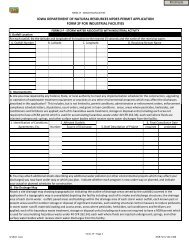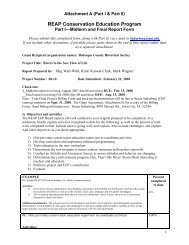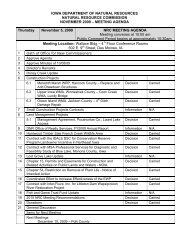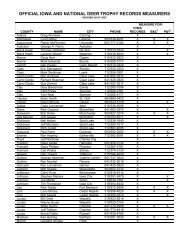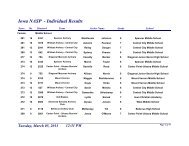You also want an ePaper? Increase the reach of your titles
YUMPU automatically turns print PDFs into web optimized ePapers that Google loves.
<strong>Trees</strong> <strong>and</strong> <strong>Buffers</strong> <strong>Boost</strong> <strong>Pheasants</strong><br />
Pheasant hunting is a time-honored<br />
tradition for Gary Olsen<br />
<strong>and</strong> his family. An Audubon<br />
County, Iowa native, Olsen remembers<br />
seeing plenty of pheasants on the<br />
home farm when he hunted as a boy in<br />
the 1960’s. In the 90’s however, the<br />
pheasant numbers dropped off on the<br />
Olsen’s l<strong>and</strong> <strong>and</strong> the successful hunting<br />
trips dropped off along with them.<br />
Olsen’s two sons, brother-in-law,<br />
three nephews <strong>and</strong> a niece all like to<br />
hunt. So he knew something had to be<br />
done to bring the pheasants back to his<br />
farm. CRP was the answer.<br />
“In the 90’s, we had to hunt anywhere<br />
we could just to see birds,”<br />
Olsen said. “Our own farms just<br />
didn’t have the pheasants anymore.<br />
We decided we wouldn’t need to hunt<br />
anywhere else if we put pheasant<br />
friendly habitats on our own l<strong>and</strong>.”<br />
Riparian buffers tie four generations together on the three Olsen farm<br />
trusts. From left, Gary Olsen, his mother Evelyn, Gary’s son Doug <strong>and</strong><br />
wife Nicki, <strong>and</strong> their children Marcus <strong>and</strong> Claire.<br />
Olsen Family Trusts<br />
Before he passed away, Olsen’s<br />
father <strong>and</strong> mother put three tracts of<br />
l<strong>and</strong> in Audubon County into trusts<br />
for Olsen <strong>and</strong> his sister. Together, the<br />
Marion Olsen <strong>and</strong> Evelyn Olsen Trusts<br />
total 600 acres. Olsen entered some of<br />
those l<strong>and</strong>s into USDA’s Conservation<br />
Reserve Program (CRP), in an effort<br />
to bring back the pheasant hunting that<br />
he <strong>and</strong> his family enjoy.<br />
“We have about 30 acres of trees <strong>and</strong><br />
60 acres of grass in riparian buffers on<br />
the three farms,” Olsen said. “Another<br />
175 acres–25 in trees <strong>and</strong> shrubs– in<br />
the general CRP brings the total CRP<br />
acres to 265.”<br />
CRP <strong>Trees</strong>, Grasses Pay Wildlife<br />
Dividends<br />
The results of converting to CRP<br />
speak for themselves.<br />
“In 1999, before the buffers were<br />
planted, we harvested two pheasants<br />
on this farm,” Olsen said.<br />
After the grasses <strong>and</strong> trees started<br />
growing, so did pheasant numbers.<br />
“I kept track <strong>and</strong> in 2001, we harvested<br />
nine pheasants,” Olsen said.<br />
“In 2002, it went to thirteen. In 2003,<br />
the harvest number went to twenty<br />
one.”<br />
The numbers continued to grow with<br />
a whopping 30 pheasants harvested in<br />
2004.<br />
Variety of <strong>Trees</strong>, Shrubs<br />
<strong>and</strong> Grasses<br />
Olsen planted a wide variety of<br />
grasses in the CRP acres. Grasses<br />
planted include big bluestem, little<br />
bluestem, sideoats grama, switchgrass,<br />
<strong>and</strong> Indian grass.<br />
“I like the big bluestem, but it is<br />
difficult to walk through as a hunter,”<br />
Olsen said. “In future plantings, I’ll<br />
use shorter grasses.”<br />
The trees planted include silver<br />
maple, black willow, cottonwood,<br />
swamp white oak, pin oak, <strong>and</strong> green<br />
ash, along with many other varieties.<br />
The shrubs used included American<br />
cranberry, ninebark, nanking cherry,<br />
<strong>and</strong> American plum.<br />
Gary Olsen has planted nearly 60<br />
acres to trees on three farms in<br />
Audubon County.
“The first planting in 2000 included<br />
7200 trees <strong>and</strong> 5000 shrubs,” Olsen<br />
said. “Since then, I’ve added another<br />
42,625 trees <strong>and</strong> shrubs.”<br />
Habitat is Hard Work<br />
In addition to tree <strong>and</strong> grass planting,<br />
Olsen made other changes to the<br />
CRP l<strong>and</strong> to improve wildlife habitats.<br />
He has established contour grass<br />
buffers <strong>and</strong> sorghum food plots, <strong>and</strong><br />
planted chickery, turnips, ladino clover<br />
<strong>and</strong> rape on the farm. Olsen also has<br />
three farm ponds <strong>and</strong> has doubled the<br />
width of his grassed waterways.<br />
Olsen hired the planting but he h<strong>and</strong>les<br />
the maintenance. Gary mowed<br />
<strong>and</strong> sprayed for thistles with permission<br />
from the Farm Service Agency.<br />
He admits it was a lot of work.<br />
“I hope I’m finished mowing now,”<br />
Olsen said.<br />
Olsen also burned for the first time<br />
last spring. “We burned 10 acres,”<br />
Olsen said. “Burning is compatible<br />
with wildlife if you burn at the right<br />
time <strong>and</strong> don’t burn too many acres in<br />
any one year.”<br />
Help from Professionals<br />
Olsen couldn’t have done all this<br />
work <strong>and</strong> planning without a little<br />
help. Ken Snyder <strong>and</strong> Jon Judson<br />
were key advisors. Snyder is a <strong>Pheasants</strong><br />
Forever promoter from nearby<br />
Carroll County. Judson, who did all<br />
the planting, owns Diversity Farms.<br />
“Ken helped me make the decision<br />
to plant buffers. He <strong>and</strong> Jon were my<br />
mentors,” Olsen said. “I didn’t realize<br />
there was so much help available to<br />
establish habitat with these buffers.<br />
They gave me the help I needed.”<br />
Olsen says credit is also due to DNR<br />
foresters Paul Tauke <strong>and</strong> Jeremy Cochran,<br />
<strong>and</strong> Dennis Heflin, Jan, Nancy,<br />
<strong>and</strong> staff at the FSA office as well as<br />
David Br<strong>and</strong>, Steve, <strong>and</strong> others at the<br />
NRCS office.<br />
“In those trees, I wouldn’t have believed<br />
the number of nests that would<br />
be made. We see lots of meadow larks<br />
<strong>and</strong> goldfinches,” Olsen said. “We’ve<br />
seen turkeys <strong>and</strong> deer, of course. But<br />
we’ve also seen quail <strong>and</strong> Hungarian<br />
partridges. We hadn’t seen quail<br />
before.”<br />
Olsen has also made jam from the<br />
nanking cherry <strong>and</strong> plum butter from<br />
the American plum.<br />
Financial <strong>and</strong> Personal Rewards<br />
“It makes sense economically to<br />
plant trees <strong>and</strong> grasses into these buffers<br />
with CRP,” Olsen said.<br />
Sorghum food plots help wildlife<br />
on his farm, but the real habitat<br />
is tree <strong>and</strong> grass riparian buffers<br />
planted along streams, Olsen says.<br />
Olsen is quick to point out that it<br />
makes sense for other reasons as well.<br />
His trees <strong>and</strong> grasses <strong>and</strong> other wildlife<br />
habitats provide a break from his<br />
job at the Friendship Home in nearby<br />
Audubon.<br />
“I enjoy them,” Olsen said. “You<br />
can’t put a value on these trees <strong>and</strong><br />
grasses.”<br />
Gary <strong>and</strong> his son Doug, along<br />
with other offspring <strong>and</strong> their<br />
families, are avid hunters <strong>and</strong> active<br />
in <strong>Pheasants</strong> Forever.<br />
Benefits of CRP Multiply<br />
Aside from bumper pheasant crops,<br />
Olsen has seen unexpected benefits<br />
from CRP plantings.<br />
Since they’ve planted trees as part of riparian buffers, Gary (right) <strong>and</strong><br />
son Doug Olsen have watched their annual pheasant harvest numbers<br />
grow from 2 to 30.



